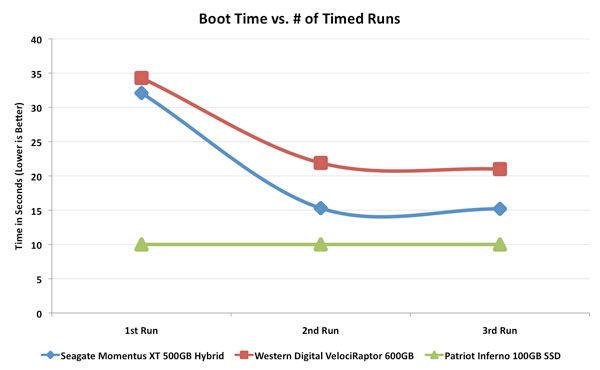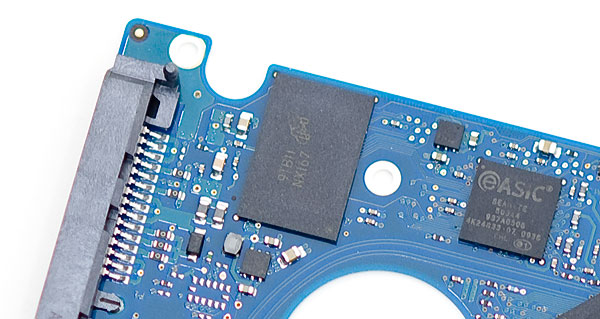Seagate's Momentus XT Reviewed, Finally a Good Hybrid HDD
by Anand Lal Shimpi on May 24, 2010 9:31 AM EST- Posted in
- Storage
- SSDs
- Seagate
- Momentus XT
- Hybrid Drive
- SSHDs
A few years ago it seemed as if Hybrid Hard Drives were the future. Yet after a bunch of announcements and hope today we find ourselves in a world with two distinct markets: HDDs and SSDs. If you're willing to pay the price premium and limit maximum capacity, today's SSDs are very fast and if you choose well, reliable.
For a desktop PC this isn't a tough choice to make. I've been advocating a setup where you have a SSD for your OS + applications and a separate RAID-1 array of 1TB or larger drives for all of your music, movies and photos.
Notebook users don't usually have a ton of drive bays and thus only have room for a single drive. It's not a lost cause though, if your notebook is your only machine you can get away with an internal SSD + external storage whether in the form of a NAS or just something you attach via USB when you're at your desk.
For the very portable users that don't want to lug around another hard drive, or for those who refuse to pay the high dollar per GB rates that SSDs command, there hasn't really been an option other than mechanical storage.

Today Seagate is attempting to change that with its latest Hybrid HDD: the Momentus XT.
More 918 Spyder than Prius
Simply put a Hybrid HDD is a mechanical drive with some NAND flash on it that is automatically used by the drive to store data for quicker access. A hybrid drive really just attempts to do what my setup of two drives (SSD + HDD) does manually: put small, frequently used data on NAND flash and put larger, less frequently used data on platters.
In theory you get the best of both worlds, the overall capacity of a HDD and (most of the time) the performance of an SSD.

Seagate's Momentus XT starts with a standard 7200PM 2.5" Momentus drive and adds a 32MB buffer, the largest on any 2.5" Momentus drive. Seagate then makes it a hybrid by adding a single 4GB SLC (!) NAND chip on the drive's PCB. Connect a controller to manage what goes into the NAND and we're in business.
| Seagate Momentus XT Drive Pricing (MSRP) | |||||
| 250GB | 320GB | 500GB | |||
| Seagate Momentus XT | $113 | $132 | $156 | ||
| Seagate Momentus 7200.4 | $55 | $55 | $85 | ||
| Seagate Momentus 5400.6 | $50 | $55 | $65 | ||
The size of the NAND was a shocker to me when I first heard it. I honestly expected something much larger. In the Momentus XT however, the SLC NAND acts exclusively as a read cache - writes never touch the NAND. The drive looks at access patterns over time (most likely via a history table of LBAs and their frequency of access) and pulls some data into the NAND. If a read request comes in for an LBA that is present in the NAND, it's serviced out of the 4GB chip. If the LBA isn't present in the NAND, the data comes from the platters.
If a read request can be serviced out of the NAND, the drive can be spun down which should save power. In practice it's rare that a sequence of reads can entirely be serviced out of NAND. What usually happens is you get a little bit of data out of the NAND and then the drive has to spin up to give you the rest. This can be a bit annoying because you get a drive spinup event in the middle of a data access rather than just before it.
The data in the NAND remains persistent across power cycles, however not formats or defrags. You still have to defragment the drive, but doing so resets the drive's learning back to zero. Defragmenting less often is the only real solution.
It's not a huge problem because the drive learns pretty quickly. By the second time you do anything the Momentus XT is usually a lot faster at the task assuming Seagate's algorithms pull any of the data you're accessing into its on-board NAND.
The chart below shows a comparison of a Western Digital VelociRaptor 600GB, a SandForce SF-1200 based SSD and the Momentus XT in boot times. I simply timed how long it took to boot into Windows 7 from the point the OS began loading to the time I got a cursor on the desktop. After a completed boot I shut down the machine and tried again.

While the first boot takes pretty long on both hard drives, by the second boot the Momentus XT is already noticeably faster than the VelociRaptor. Seagate appears to focus mostly on small, frequently used files and aggressively pulls them into the NAND.
The chart also illustrates a very important point. The SSD's performance is consistent even compared to the first run, while the Momentus XT needs to run through a workload once before it's optimized. This applies to more than just boot time, application loads or any sort of disk access.
Over a short period of time the Momentus XT should get many of the small files you use regularly into its NAND cache but the drive is best optimized for repeatable usage patterns. If you always use the same few applications in the same way the Momentus XT will work very well. I found that it's not very difficult to get data evicted from the NAND cache if you throw a random set of applications/workloads at the drive.
Why a Read Cache?
I've written a lot about the struggles that SSD controllers must deal with to manage writing and re-writing NAND. It's not surprising that Seagate opted to use the NAND on the Momentus XT as a read-only cache. Seagate controls what data gets written to the NAND, which makes block management much simpler. There's never a situation where the drive doesn't know what it needs to keep track of. And by using SLC instead of MLC NAND, Seagate doesn't even have to worry about aggressive wear leveling either. So it's about simplicity, not the perfect hybrid design.

Seagate claims that the 4GB size offered the best balance of price/performance, but I suspect that with more aggressive caching algorithms Seagate could benefit from a larger cache. With more NAND Seagate could also prefetch data into the cache. And eventually, if there is to be a future for hybrid drives, Seagate will have to enable a NAND write cache.
Once you start caching writes as well then you effectively make the jump into the SSD realm in terms of complexity. The read-only design is pretty simple but until we see Seagate enter the consumer SSD space I doubt we'll see a more aggressive hybrid drive.
Note that you shouldn't expect to get the same performance out of the Momentus XT's single NAND device as you would an SSD. Remember that modern SSDs have anywhere between 4 and 10 channels of NAND accessed in parallel to reach their very high transfer rates. A single NAND device isn't going to end up anywhere near as fast. At best the Momentus XT should be able to read from the cache at 20 - 40MB/s depending on the data being accessed and the type of NAND Seagate is using.










120 Comments
View All Comments
Faruk88 - Monday, May 24, 2010 - link
Hey Anand,As always I love your reviews - great job!
I have a quick question: Does this drive constantly spin up and spin down to save power? The reason I ask is because this puts a lot of wear on the mechanical drive.. so I would stay away from this drive if that is the case.
I still wonder why no drive manufacturer has tried to pair 60-80GB of flash with a mechanical drive and combine it into one 2.5" package. Instead of having a hybrid drive like this, I would rather have one Flash partition for my OS and apps, and one partition on the mechanical drive for the rest of my data. This would be useful for laptops, which usually only have one drive bay. Obviously the two "drives" would have to share the SATA bus, but I think the advantages would outweigh the disadvantages.
Faruk
kmmatney - Monday, May 24, 2010 - link
I would also like a system like that. You can also backup for flash partition to the mechanical partition.void2 - Monday, May 24, 2010 - link
Core i3-350M, 5400 RPM 2.5" HDD, clean Windows 7 - and I get ~30 seconds from power button to web browser (~22 seconds if I would install "Boot Cooler", but that's not the point). You, on the other hand, get ~50 seconds on "partial" boot sequence (no POST, no web browser) and much more powerful CPU. It definitely looks like Windows 7 ReadyBoot (successor to "regular" WinXP boot prefetch) did not have enough time to learn. So this does not look like real-life comparison.Drag0nFire - Monday, May 24, 2010 - link
With any notebook HDD, one of the most important considerations for me is how noisy it is. I really value a quiet notebook.Although I know this won't be as quiet as an SSD, could you describe the noise characteristics? Can you hear it at idle? Seeking?
Thanks Anand!
wyemarn - Monday, May 24, 2010 - link
Tom's came up with an article comparing XT with a plain Momentus 7200.4http://www.tomshardware.com/reviews/seagate-moment...
nickkb - Monday, May 24, 2010 - link
The Tom's Hardware review was almost a polar-opposite of Anand's. They performed a number of tests but did not include what I think is absolutely crucial to the intended purpose of this drive: the Boot Time vs. # of runs. I don't know what they intended to extract from all of their tests, as the base storage media of this drive is mechanical, not flash. Therefore, it comes as no surprise that the XT performed almost on-par with the vanilla version of the Momentus 7200.4 in many of their tests.leexgx - Monday, May 24, 2010 - link
most of tomshardware is just junk most of the time and i recommend no one going onto there site as you just end up asking more questionsfboone1 - Monday, May 24, 2010 - link
I'm definitely intrigued by this drive. If I were to put 2 of them in a RAID 0 array, what would happen? Would I have effectively 8GB of NAND cache? Would doing so greatly increase performance?BJ Eagle - Wednesday, May 26, 2010 - link
I for one would certainly alspo like to see RAID 0 and 1 results. I would suspect that this Momentus XT drive would benefit similiar to RAID as traditional harddrives, but it would be nice to have it confirmed.CharonPDX - Monday, May 24, 2010 - link
Since when is a third of a Watt at idle, three-quarters of a Watt at load, "consider[ably] more power"?
With most notebooks nowadays having a 40 Watt-hour batteries or higher, an increase of one Watt won't exactly kill battery life. And that's assuming it's going constantly at full power.